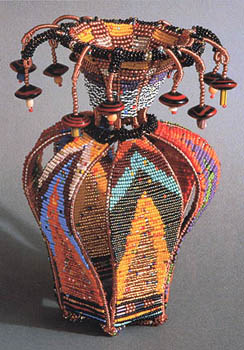|
March 23-April 28 We're
playing with beads by the thousand. It's only been a decade since
our field rocketed from obscurity to prominence with the publication
of The New Beadwork. Now, so many artists choose beadwork as their
primary medium that it's hard to keep track of it all. Our field
is fertile and increasingly sophisticated.
Judging by applications to The Freed Bead, we form a pretty diverse group. Some of us have degrees in the fine or applied arts, and some have little experience in the arts. Some of us have taken beadworking classes with charismatic teachers like Joyce Scott, Carol Wilcox Wells, David Chatt, and NanC Meinhardt. Others are entirely self-taught. Many of us work with beads for the fun of it. Others strive to communicate with the world through their work. Preparing to write these paragraphs, I called a dozen or so artists and asked them to explain what inspires their work. I wasn't prepared for the diversity of answers, or the intense personal commitment to the medium that many expressed. Now, inspiration is a slippery something that can be difficult, even impossible to articulate. We don't always know why we make something. But certain themes began to recur as the calls progressed, and eventually I could see the rough outlines of five sources of inspiration. The first source might be called internal states of being or emotions. Artists such as Wendy Seaward, Sherry Bittle, and Kim Z. Franklin work in this way by looking inward. Some of these pieces are intense, even haunting. Sherry Bittle, for example, made Shroud as an expression of grief over her brother's death and as a kind of tribute to him. A second source of inspiration lies in what could be called the essence of things. For Natasha St. Michael, this essence can be found in cellular formations or as she puts it, "what lies beneath." For Gail Gorlitzz, the essence flows from "life energy." If life energy could be expressed in form, she feels, it would take the shape of a spiral. Celebrations of life form a third source of inspiration. Artists working in this mode include Laura Leonard and Cindy Wrobel. In pieces like Goddess of Love and Laundry, Laura gives us wry 3D snapshots of ourselves in our day-to-day activities. Working quickly and extemporaneously, Cindy makes her vessels asymmetrical on purpose, as if to capture them in mid-movement. Pop culture is another source of inspiration. Joseph Barbaccia's Marilyn quotes both the actress as icon and the artist who plastered the world with her image, Andy Warhol. At the same time, the piece mirrors our own obsession with these celebrities. With its clever transformation of Cheerios into art, Vicki Schroeder's Cereal Jar I is built with the very stuff of global consumerism: commercial breakfast cereal. A fifth group of artists finds inspiration in the work of other artists both living and dead. Sharon Donovan made her elegant Treasure House bracelet in response to a 10th century Japanese beaded temple lantern. The bracelet brilliantly reconfigures the graceful aesthetic of the lantern. Myrle Borine finds inspiration in bargello and wallpaper patterns. Virginia Pledger admires and works in response to the work of Viennese artist Jacqueline Lillie. How free we seem, how unfettered we are. May we always go forth and bead. |
 Beadwork
Unbound: Freedom of Inspiration in an Emerging Field
Beadwork
Unbound: Freedom of Inspiration in an Emerging Field